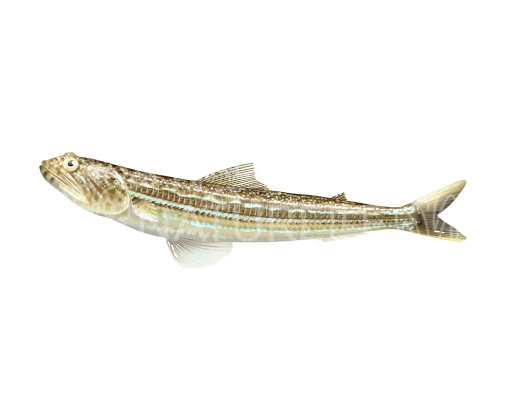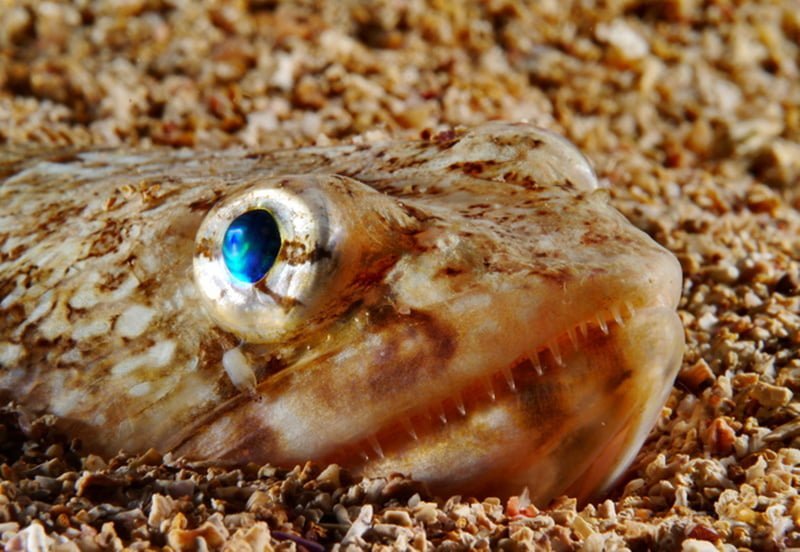Synodus Saurus
– Striped Lizardfish –

| Conservation status |
|---|
 Least Concern (IUCN 3.1)[1] |
| Scientific classification |
Synodus saurus
(Linnaeus, 1758)
| Kingdom: | Animalia |
| Phylum: | Chordata |
| Class: | Actinopterygii |
| Order: | Aulopiformes |
| Family: | Synodontidae |
| Genus: | Synodus |
| Species: | S. saurus |

The Striped lizardfish (Synodus saurus), is a species of lizardfish that primarily lives in the Eastern Atlantic.
Description
The striped lizardfish is a fish with an elongated cylindrical body , reaching up to 40 cm . The head is flattened and triangular in shape . The mouth, with many fine and pointed teeth often clearly visible , is wide and stretches far behind the eyes. These are green surrounded by an orange ring and located on the upper part of the head. The body is clear , darker on the back with blue or white horizontal lines . Dark spots more or less marked descend from the back which can form vertical bars. The coloring can be more or less dark depending on that of the substrate on which it is located. The dorsal fin is small and triangular, and behind it is a small fatty fin .
Similar Species
There are several other species of lizardfish in the same geographic area that could be confused with Synodus saurus :
Synodus synodus (Tropical East Atlantic to the Canary Islands in the north) has a more red coloration, with wide and dark vertical bands, a black point on the muzzle. There are no blue or white longitudinal lines.
Synodus intermedius (Caribbean) closely resembles S. saurus but has a black spot on the operculum.
Synodus foetens (Caribbean) has no transverse bands or lateral lines, but has a few dorsal spots.
In the eastern Mediterranean, it is possible to meet other species of lizardfish, native to the Red Sea having traveled through the Suez Canal.
Finally, the vives ( Trachinus sp ) are found in the same biotope, but have a rounder head and a second dorsal fin running over half the body.
Biotope
This species is found on sandy bottoms, from a few meters below the surface to about twenty meters deep (max 400 m).
Alimentation
The striped lizardfish hunts on the lookout, buried in the sand, leaving only its eyes set on the upper part of the skull protruding. It then catches the preys which pass within reach of its mouth, mainly fish, but also cephalopods and crustaceans. This important predator will not hesitate to soar like an arrow on a fish passing nearby, even if it means leaping up to several meters above the bottom. It is in particular a predator of the post-larvae of the yellow-mouthed barracuda ( Sphyraena viridensis ).
Reproduction
Synodus saurus is a gonochoric * species (the sexes are separate). Reproduction takes place in spring and summer. Fertilization is external. A study carried out in the Azores shows that there is also significant competition between males during the breeding season.
Associated Life
Like many fish, the striped lizardfish can be parasitized, in particular by crustaceans (copepods, isopods, etc.).
Various Biology
The striped lizardfish, like most bottom-dwelling fish, does not have a swim bladder.
Further Information
Its white flesh is edible.
In recent years, observations of S. saurus in the northern Mediterranean have become more and more frequent, probably linked to global warming.
The Atlantic lizardfish is known to be found in a marine environment within a general demersal depth range of about 400 meters. They are more specifically found in a depth range of about 20 meters. This species is native to a subtropical climate. The maximum recorded length of the Atlantic lizardfish as an unsexed male is about 40 centimeters or about 15.74 inches.[2] The distribution of this species occupies the areas of Eastern Atlantic, Morocco, Cape Verde, Azores, Mediterranean, Western Atlantic, Bermuda, Bahamas, Lesser Antilles, and the Leeward Islands.[3] This species is mainly known to be found in insular waters and on top of sandy or sand-rock bottoms.[2] The diet of the Atlantic lizardfish mainly includes other species of fish, but it is known to also feed occasionally on other animals. The Atlantic lizardfish can be found occupying waters around islands.[4] The Atlantic lizardfish keeps itself hidden and camouflaged by burrowing itself in the sand.[1] While it is burrowed in the sand, this species reveals his eyes so that it can watch its prey and pounce when food is available.[5]
































































































































































































































































































































































































